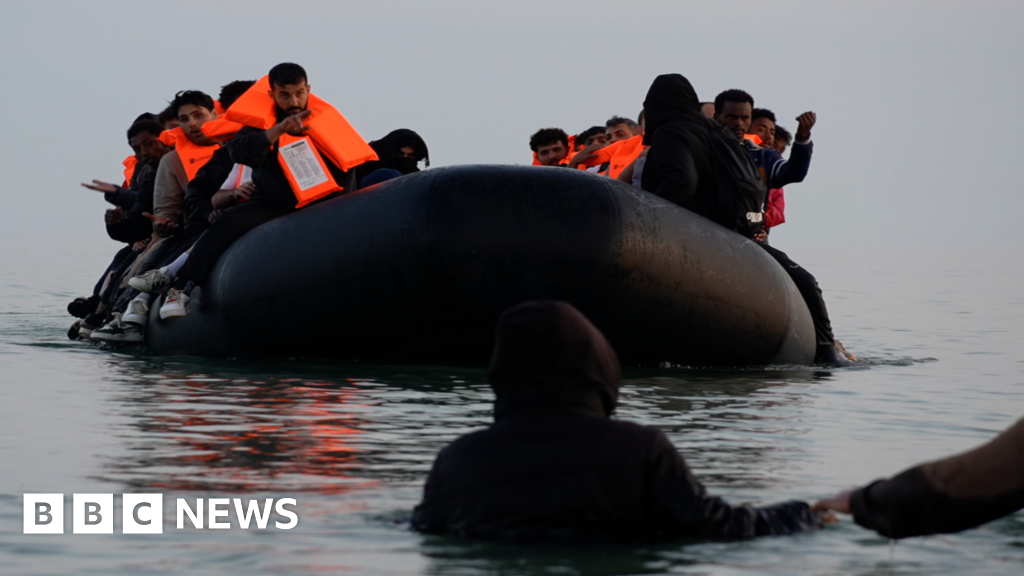As the weather in the Channel clears, the French police are struggling to halt a potentially record-breaking surge of people from reaching the UK in small boats organised by a growing network of smuggling gangs. Downing Street said on Tuesday the situation was “deteriorating.”
Although the French authorities claim they’re now intercepting more than two thirds of those boats before they reach the sea, the smugglers are now changing tactics to launch so-called “taxi boats” from new sites, in new ways, and with ever greater speed.
Instead of inflating their boats in the dunes along the coast, close to police patrols, the gangs are launching them from better hidden locations, often dozens of kilometres from the main departure beaches. They then cruise along the coastline, like taxis or buses, picking up their paying customers who now wait in the sea, out of reach of the police.
Just before sunrise, last Friday, a group of perhaps 80 people gathered in calm, waist-deep water, off a beach near the village of Wissant, south of Calais. There were several women and children in the group, from countries including Eritrea and Afghanistan. We counted eighteen French gendarmes watching them from the shore, declining to intervene.
An inflatable taxi boat, operated by a smuggling gang, had just arrived by sea and now circled repeatedly. Over the course of perhaps ten minutes, one man sitting at the front of the boat appeared to usher people forwards, to clamber onboard in relatively organised, even orderly, groups.
Several children clung, occasionally crying, to their relatives’ shoulders. “Yes, to England,” one Afghan man told me, patiently waiting his turn, his eyes focused firmly on the boat.
The taxi boat system appears to give the smugglers a little more control over what has often been a chaotic, and dangerous process, involving large crowds dragging boats to the water and then scrambling onboard.
A little over a year ago, I watched the result on a nearby beach when about a hundred migrants tried to pile onto the same boat. Five people, including a seven-year-old girl, were trampled or suffocated to death.
On Friday morning, Colonel Olivier Alary stood, dry-footed, watching the taxi boat load up. He explained that the current operational rules for his forces were clear. They would intervene to rescue someone if they were about to drown. They might even attempt to stop the boat if it became trapped on a sandbank. But it was simply too risky, for all involved, for the police to try to reach the boat now it was afloat.
“The police will be able to do more… if the rules governing our actions at sea are changed,” said Alary, referring to the French government’s declared intention to revise those rules, possibly in the coming weeks, to give the police more leeway.
Although some officers say there is already some wiggle-room for the police in terms of how strictly they interpret the existing rules, many are fearful that they might face serious legal trouble.
One unintended consequence of the smuggler’s growing dependence on the taxi boat system is that it gives young men an advantage over women and children, who often struggle to climb onboard from the sea.
All in all, it had not been a good night for the French police. Alary’s forces claimed four successful interceptions on land. But along the whole coast, a total of 14 boats had made it to sea, carrying 919 people to the UK.
Later that morning, on a brief trip to sea on a police patrol boat, Colonel Alary reflected on the battle to stop the smugglers. There were so many challenges – from the heavy equipment worn by police which made it dangerous for them to enter the water safely, to the inherent instability of the inflatable boats, which made them too vulnerable to stop at sea without risk of drownings.
But Alary said the UK itself held the key to solving this crisis. “It should be kept in mind that 30% of all the migrants entering the European Union end up here, in the Calais area. They travel from all over Europe to come here… because the United Kingdom is attracting them. England is attractive. It encourages migrants to want to join it. The solution is to make England less attractive, then people would remain [at home or in the EU].”
On a much windier day last week, on a beach beside an old Bourbon-era fort in the village of Ambleteuse, I met a former fisherman, Stéphane Pinto, who is now the local mayor. “For migrants, the UK is still seen as an El Dorado. The British need to address this issue more forcefully,” he said. If it didn’t, Pinto warned of growing violence between police, local communities, and a rising wave of migration from an increasingly troubled world.
Source link




